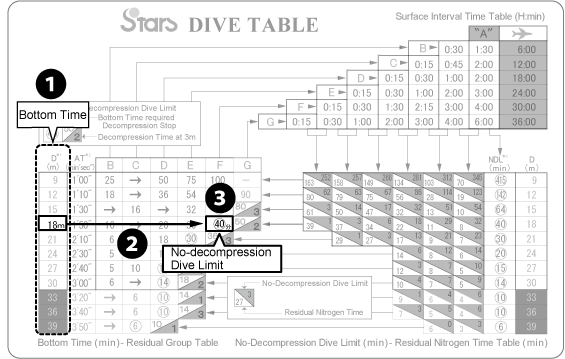【Table 1】 The usage of Bottom Time – Residual Group Table |
【Table 1】 In Bottom Time – Residual Group Table, you can examine three information mainly.
- How long are you able to dive for your planning depth?
- How much is the quantity of nitrogen in body at the time of first diving end?
- How long is Surfacing Time from each depth for safety?
|
 You are able to examine the No-decompression Dive Limit You are able to examine the No-decompression Dive Limit
|
You are able to examine the time that you are able to stay at your planning depth.
 |
How long is your No-decompression Dive Limit in case of your planning depth is 18m? |
|
《The usage of Dive Table》
① You look for 18m from diving depth (D).
② You trace 18m aside and look for a circled number.
③In case of your planning depth is 18m, your No-decompression Dive Limit is 40 minutes. |
|
 |
 |
- When there is not the same number about Diving Depth and Bottom Time, you should use the next big number for safety.
- The diving at the maximum depth that is shallower than 9m should be considered as the diving at the 9m deep.
|
|
【The Dive Table term】
■Diving depth
The maximum depth for one diving
■Bottom Time
The time between the start of descent and the start of surfacing
(The time for Safety Stop and Decompression Stop is not involved)
■No-decompression Dive Limit
The maximum Bottom Time for that you need not decompression stops. |
|

